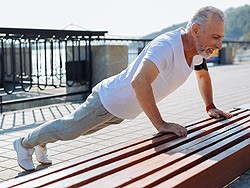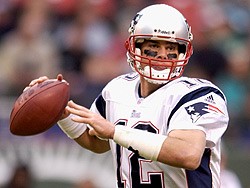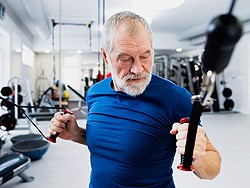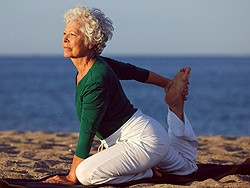My Uncle Joe was ahead of his time. One day during the year he turned 96, he strode into the living room where my family was gathered, his head high and chest out, and shook everyone's hand in greeting. When my turn came, his grip felt like a vise closing on my fingers.
I said, "Uncle Joe, you're almost 100 years old. How have you stayed so strong?"
 "I get up every day at 5:30," he said. "I spend a half hour
on calisthenics. I eat bran and fruit. Then I play 18 holes of golf, walking
from one hole to the other."
"I get up every day at 5:30," he said. "I spend a half hour
on calisthenics. I eat bran and fruit. Then I play 18 holes of golf, walking
from one hole to the other."
You could forgive most of Uncle Joe's peers if they thought that kind
of routine was too much bother. Most people got all the exercise they
could stand while washing clothes, carrying bricks, and digging ditches.
They walked almost everywhere they went.
But the average life expectancy when Uncle Joe was born was 47 years.[1,2] The leading cause of death in those days was infectious diseases.[2] The flu epidemic of 1918, for example, struck down the young more often
than the old.[3] So planning to turn 96 didn't make sense for most people.
When we turn 40, we can no longer afford to say, 'I'm too old now to be an athlete.' Instead, we need to start training for the next 60 years of physical activity.
Today we all need to live like Uncle Joe. And as sports physicians, our job is to help our patients get with his program. The average life expectancy in the United States is now almost 80 years. When we turn 40, we can no longer afford to say, "I'm too old now to be an athlete." Instead, we need to start training for the next 60 years of physical activity.
Nowadays in the United States, far fewer people get exercise as part of their jobs. Most people drive everywhere. Vaccination, pasteurization, and sanitation have lifted much of the burden of infection, but a third of Americans are obese. As a result, the leading causes of death are heart disease and cancer.
These factors should shape the way we as sports physicians look at our patients. For many, osteoarthritis stands between them and a healthy future. When arthroplasty started, the goal might have been to help people hobble around their houses with canes for a few more years before they died. Now we need to see total knee and hip replacements as tools that allow our patients to exercise vigorously. We also have to teach our patients that getting their heart rates going every day is essential—but it's not enough. Resistance training can help hold back the tide of osteoporosis, sarcopenia, and denervation that makes the elderly frail.
That's why I tell my patients that they should not only increase the amount of time they spend exercising as they get older, but they should also change the way they are exercising. Once everybody turns 30, the maintenance required goes up exponentially each decade. We start to see knees and other cartilage breaking down. The human body loses speed, power, and resilience. That process is on display in professional athletes, most of whom have to quit their jobs between ages 33 and 35.

There are exceptions, like Tom Brady, still throwing touchdowns at age 40, or Dara Torres, who won Olympic silver medals in swimming at age 41. We have a lot to learn from the way these athletes changed their routines to stay in the game. But we have even more to learn from the way master athletes pursue sports in their older decades—people like Ed Whitlock who, at 85 years of age, set the distance-running record for his age group, completing the 2016 Toronto Waterfront Marathon in 3 hours 56 minutes 34 seconds and becoming the oldest person to run 26.2 miles in under 4 hours.
As the decades progress and high-intensity workouts become more difficult, our patients should continue to diversify their fitness regimens. They can alternate among cycling, swimming, hiking, or weightlifting, for example. Interval training, which combines brief bouts of high-intensity exercise with longer, lower-intensity exercise, can be particularly beneficial in middle age and beyond.

Even as resistance training becomes more important, most people have to
reduce the amount of resistance and increase the number of repetitions.
Exercises that emphasize balance, especially proprioception, become more
important.
One of the most important concepts I've tried to promote through my book,
The Win Within,
is that you are what you eat, drink, think, and do. Just as exercise has
to change when our patients reach middle age, so does their diet. With
less lean body mass, metabolism slows and the risk for diabetes increases.
So the older our patients get, the more they should avoid foods with a
high glycemic index.
While added sugar is still all too prominent in grocery stores and restaurants, low-carbohydrate foods are becoming more available. Let's guide our patients to take advantage of trends such as Greek yogurt, with its higher quotient of protein, or new recipes like one of my favorites: mock mashed potatoes made with cauliflower.

The cultivation of mental health also becomes increasingly important with age. Research has increasingly validated the value of practices such as yoga and tai chi, which combine meditation with movement.[4-6] They can be as powerful as medication in reducing joint pain and cardiovascular risk, and in improving mood, but with fewer adverse effects.
Physical activity works on a genetic level, too, switching genes on and off like apps on an iPhone.[7] Some epigenetic information can be passed from one generation to another. We have an opportunity to affect not only our patients but also generations to come.
References
- Hacker JD. Decennial life tables for the white population of the United States, 1790-1900. Hist Methods. 2010;43:45-79. Abstract
- Tippett R. Mortality and cause of death, 1900 v. 2010. Carolina Demography. http://demography.cpc.unc.edu/2014/06/16/mortality-and-cause-of-death-1900-v-2010/ Accessed September 19, 2017.
- Simonsen L, Clarke MJ, Schonberger LB, Arden NH, Cox NJ, Fukuda K. Pandemic versus epidemic influenza mortality: a pattern of changing age distribution. J Infect Dis. 1998;178:53-60. Abstract
- Brook RD, Appel LJ, Rubenfire M, et al; American Heart Association Professional Education Committee of the Council for High Blood Pressure Research, Council on Cardiovascular and Stroke Nursing, Council on Epidemiology and Prevention, and Council on Nutrition, Physical Activity. Beyond medications and diet: alternative approaches to lowering blood pressure: a scientific statement from the American Heart Association. Hypertension. 2013;61:1360-1383. Abstract
- Wieland LS, Skoetz N, Pilkington K, Vempati R, D'Adamo CR, Berman BM. Yoga treatment for chronic non-specific low back pain. Cochrane Database Syst Rev. 2017 Jan 12;1:CD010671.
- Shapiro D, Cook IA, Davydov DM, Ottaviani C, Leuchter AF, Abrams M. Yoga as a complementary treatment of depression: effects of traits and moods on treatment outcome. Evid Based Complement Alternat Med. 2007;4:493-502. Abstract
- Lindholm ME, Marabita F, Gomez-Cabrero D, et al. An integrative analysis reveals coordinated reprogramming of the epigenome and the transcriptome in human skeletal muscle after training. Epigenetics. 2014;9:1557-1669. Abstract
